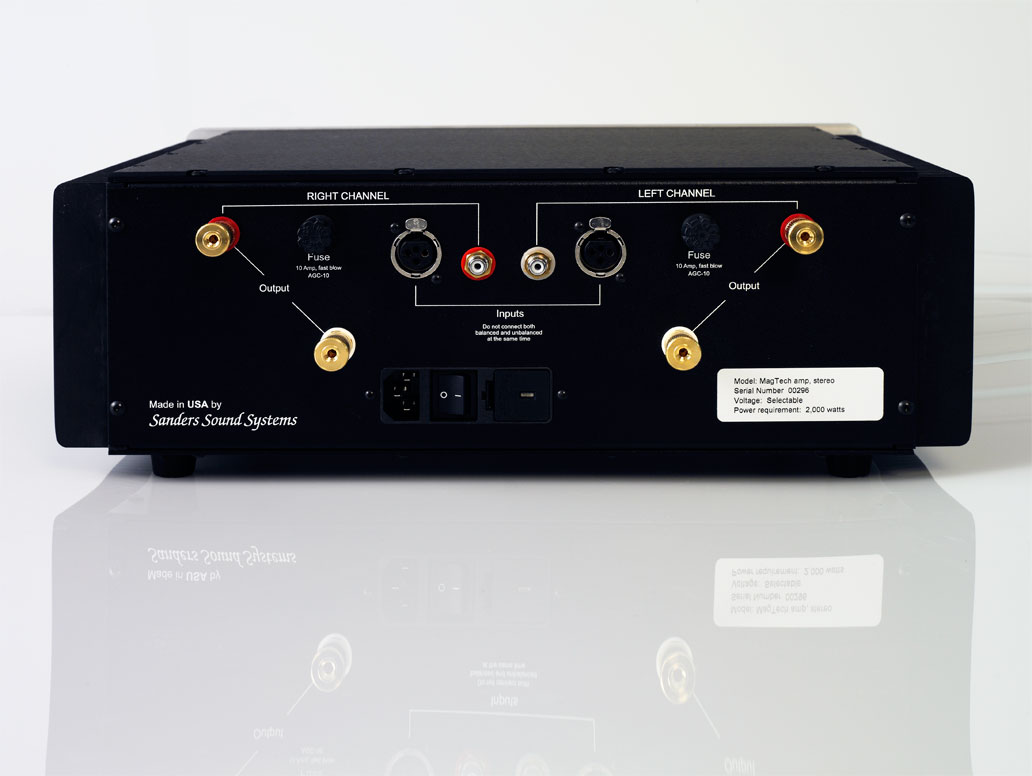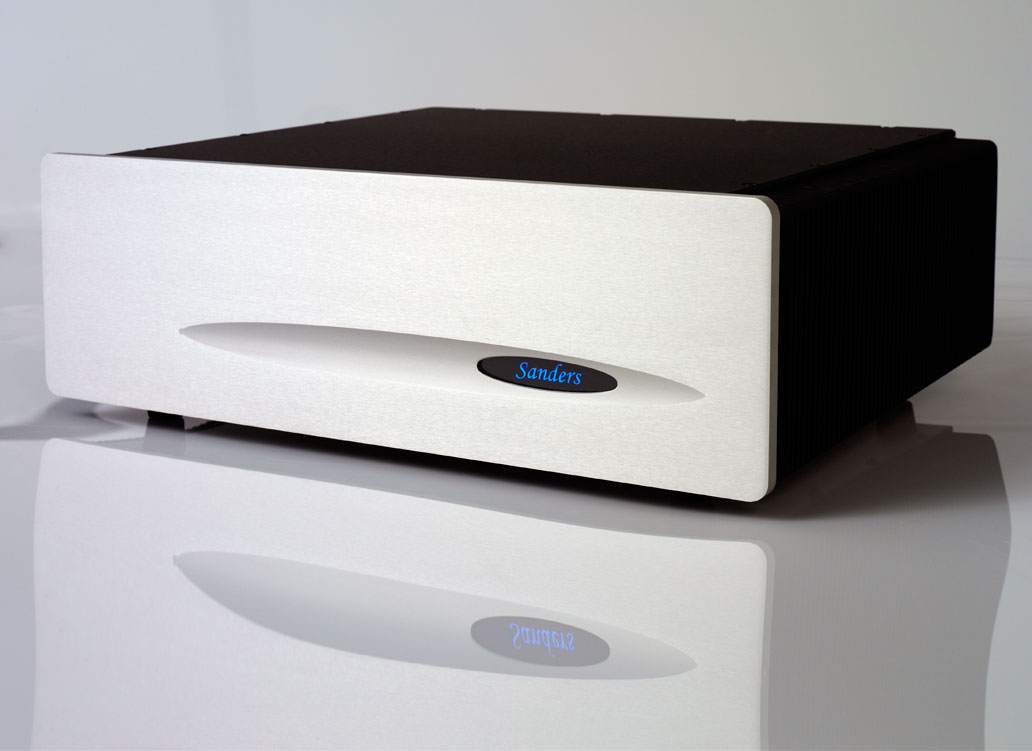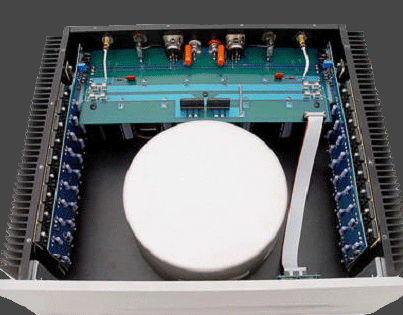Price: $6,000
This amplifier will deliver more than 2000 volt-amps per channel into an ESL, and when driving magnetic speakers, the ESL amplifier will deliver over 400 watts/channel into an 8 ohm load and 780 watts into a 4 ohm load.
The Sanders ESL amp Mk II is the latest in a long series of upgrades to improve this unique amplifier that is designed to drive the most difficult of all speaker loads -- electrostatic loudspeakers (ESLs). This is an extensive topic that is covered in the "White Papers" section on this website, so please refer to those papers for technical details.
(Place links to the white papers on the ESL amp and ESL Amp Bias here)
The ESL amp originally was designed in 1998 by popular demand in response to electrostatic speaker owners' request for an amplifier that could drive this type of speaker well. Since the most common type of speakers are the magnetic speaker types, most amplifier manufacturers do not design their amplifiers for electrostatic speakers. As a result, most have problems driving these difficult speakers.
In essence, the ESL amp solves this problem by using such a massive output stage (20 large output transistors, which are able to deliver 7,000 watts) that the transistors are never stressed by the demanding load of an electrostatic speaker and therefore protective circuitry is not required or used. Additionally, the amplifier can safely drive an 1/3 ohm load, which is often seen in ESLs at supersonic frequencies.
Since it is protective circuitry that causes the harshness and stridency usually heard in transistor amplifiers, eliminating it is the key to producing superb sound quality. The result is a solid state amplifier that sounds as smooth and rich as tube amplifiers, but without the impedance and voltage problems that tubes have when driving ESLs. For more information on this topic, please see the "Tubes vs. Transistors" White Paper elsewhere on this site.
(Insert a link to the white paper here)
Additional features of the ESL amp is that it has been designed to be compact enough to be placed on a shelf and it is very efficient so that it runs just slightly warm. This high efficiency eliminates the waste of massive amounts of electricity like most amplifiers. It does not heat your room, so does not require additional waste in the form of extra air conditioning.
The new features that produce the Mk II version of the ESL amp is the use of a new, higher voltage, more powerful power supply transformer and the use of Thermal Trak transistors. The new toroidal transformer is potted in epoxy and covered with a metal shield so that there is no stray magnetic fields to cause hum. The additional power and voltage increases the power to over 400 watts/channel into an 8 ohm load and to 780 watts into a 4 ohm load.
This has special significance when driving ESLs, which are actually driven by voltage, not current as is the case with magnetic speakers. The ESL amp Mk II can drive 64 volts (RMS) into an ESL. This will play them at very loud levels and makes it possible to reproduce dynamic music at live levels with ESLs that are capable of such performance.
The bias levels in conventional solid state amplifiers are highly unstable. This is due to the fact that the bias is highly variable depending on the temperature in the output transistor junctions. The junctions are very small, so sudden large changes in the electrical current passing through them will cause an instantaneous and dramatic increase in the bias.
Well designed, conventional amplifiers try to deal with this by sensing the temperature of the heat sinks upon which the transistors are mounted. But it takes several minutes for the heat in the transistor junction to soak into a massive heat sink and change its temperature.
As a result, monitoring the heat sink temperatures can only control the average bias over time, not the instantaneous junction temperatures. Therefore it is common for the bias in a conventional amplifier to vary by several hundred percent despite heat sink temperature monitoring.
Since transistor junction heat causes an increase in the bias current, and bias current causes an increase in the junction temperature, "thermal runaway" can occur and the transistor will fail due to excessive temperature. Protective circuitry usually is necessary to prevent this.
But the recent development of "Thermal Trak" transistors solves all these problems. Thermal Trak transistors have a microscopic temperature sensor built right into the junction of the transistor. It is therefore possible to monitor the temperature of the transistor junction in real time and use that information to adjust the amplifier's bias instantly to maintain an absolutely stable bias current under all conditions. This assures that the bias will always be at an optimum level with no chance of thermal runaway.
The result of using Thermal Trak transistors means that the Mk II ESL amplifier's bias can be optimized for extremely low distortion levels with minimum heat production. It also means that the warm-up time for the amplifier (where the bias is optimal) is only a few of minutes instead of several hours.
The quality of construction is typical of the finest components being made today.
No capacitors are used in the signal path.
Resistors are high-reliability, precision, metal film, 1% tolerance.
Connectors are gold or rhodium plated.
Both unbalanced (RCA) and balanced (XLR) input connectors are standard.
The finest quality, German, gold-plated, WBT binding posts are used. These are widely spaced and positioned at a 45 degree angle for ease of use and speaker cable routing.
The amplifier is modular in construction for easy servicing or upgrading.
Available with either black or silver face plates.
The line voltage is user-selectable from the rear panel so the amplifier can be used anywhere in the world without having to be modified at the factory for different voltages.
POWER (stereo version): 400 watts RMS per channel into an 8 ohm load, both channels driven from 20 Hz to 20 KHz. 780 w/c into a 4 ohm load.
POWER (monoblock version): More than 1,200 watts @ 8 ohms. More than 2,000 watts @ 4 ohms.
VOLTAGE (when driving an electrostatic loudspeaker): 64 Vrms (stereo), 128 Vrms (mono)
CLASS OF OPERATION: Class AB
BANDWIDTH: DC through 100 KHz
INPUT VOLTAGE FOR FULL OUTPUT: 2.2 Vrms
INPUT IMPEDANCE: 50,000 ohms balanced and unbalanced
NOISE: More than 120 dB below rated output
DAMPING FACTOR: Greater than 800 into an 8 ohm load
DISTORTION (both THD and IMD): Less than 0.01% at rated power and full bandwidth. Typically less than 0.0028% at small signal levels.
Net Weight: 54 pounds (24.5 KG)
The Sanders ESL amp Mk II is the latest in a long series of upgrades to improve this unique amplifier that is designed to drive the most difficult of all speaker loads -- electrostatic loudspeakers (ESLs). This is an extensive topic that is covered in the "White Papers" section on this website, so please refer to those papers for technical details.
ESL Amp White Paper
ESL Amp Bias White Paper
The ESL amp originally was designed in 1998 by popular demand in response to electrostatic speaker owners' request for an amplifier that could drive this type of speaker well. Since the most common type of speakers are the magnetic speaker types, most amplifier manufacturers do not design their amplifiers for electrostatic speakers. As a result, most have problems driving these difficult speakers.
In essence, the ESL amp solves this problem by using such a massive output stage (20 large output transistors, which are able to deliver 7,000 watts) that the transistors are never stressed by the demanding load of an electrostatic speaker and therefore protective circuitry is not required or used. Additionally, the amplifier can safely drive an 1/3 ohm load, which is often seen in ESLs at supersonic frequencies.
Since it is protective circuitry that causes the harshness and stridency usually heard in transistor amplifiers, eliminating it is the key to producing superb sound quality. The result is a solid state amplifier that sounds as smooth and rich as tube amplifiers, but without the impedance and voltage problems that tubes have when driving ESLs. For more information on this topic, please see the "Tubes vs. Transistors" White Paper section on this site.
Tubes vs Transistors Whitepaper
Additional features of the ESL amp is that it has been designed to be compact enough to be placed on a shelf and it is very efficient so that it runs just slightly warm. This high efficiency eliminates the waste of massive amounts of electricity like most amplifiers. It does not heat your room, so does not require additional waste in the form of extra air conditioning.
The new features that produce the Mk II version of the ESL amp is the use of a new, higher voltage, more powerful power supply transformer and the use of Thermal Trak transistors. The new toroidal transformer is potted in epoxy and covered with a metal shield so that there is no stray magnetic fields to cause hum. The additional power and voltage increases the power to over 400 watts/channel into an 8 ohm load and to 780 watts into a 4 ohm load.
This has special significance when driving ESLs, which are actually driven by voltage, not current as is the case with magnetic speakers. The ESL amp Mk II can drive 64 volts (RMS) into an ESL. This will play them at very loud levels and makes it possible to reproduce dynamic music at live levels with ESLs that are capable of such performance.
The bias levels in conventional solid state amplifiers are highly unstable. This is due to the fact that the bias is highly variable depending on the temperature in the output transistor junctions. The junctions are very small, so sudden large changes in the electrical current passing through them will cause an instantaneous and dramatic increase in the bias.
Well designed, conventional amplifiers try to deal with this by sensing the temperature of the heat sinks upon which the transistors are mounted. But it takes several minutes for the heat in the transistor junction to soak into a massive heat sink and change its temperature.
As a result, monitoring the heat sink temperatures can only control the average bias over time, not the instantaneous junction temperatures. Therefore it is common for the bias in a conventional amplifier to vary by several hundred percent despite heat sink temperature monitoring.
Since transistor junction heat causes an increase in the bias current, and bias current causes an increase in the junction temperature, "thermal runaway" can occur and the transistor will fail due to excessive temperature. Protective circuitry usually is necessary to prevent this.
But the recent development of "Thermal Trak" transistors solves all these problems. Thermal Trak transistors have a microscopic temperature sensor built right into the junction of the transistor. It is therefore possible to monitor the temperature of the transistor junction in real time and use that information to adjust the amplifier's bias instantly to maintain an absolutely stable bias current under all conditions. This assures that the bias will always be at an optimum level with no chance of thermal runaway.
The result of using Thermal Trak transistors means that the Mk II ESL amplifier's bias can be optimized for extremely low distortion levels with minimum heat production. It also means that the warm-up time for the amplifier (where the bias is optimal) is only a few of minutes instead of several hours.
FEATURES
-
The quality of construction is typical of the finest components being made today.
-
No capacitors are used in the signal path.
-
The amplifier runs very cool.
-
Resistors are high-reliability, precision, metal film, 1% tolerance.
-
A massive output stage using 20 transistors makes the amplifier extremely rugged and reliable. It will drive the most difficult (low impedance and reactive) loads without strain or damage, which is why it is ideal for driving electrostatic loudspeakers.
-
Connectors are gold or rhodium plated.
-
Both unbalanced (RCA) and balanced (XLR) input connectors are standard.
-
The finest quality, German, gold-plated, WBT binding posts are used. These are widely spaced and positioned at a 45 degree angle for ease of use and speaker cable routing.
-
The amplifier is modular in construction for easy servicing or upgrading.
-
The line voltage is user-selectable from the rear panel so the amplifier can be used anywhere in the world without having to be modified at the factory for different voltages.
-
Available with either black or silver face plates.

SPECIFICATIONS OF ESL MARK II AMPLIFIER
Power (Stereo Version)
both channels driven from 20 Hz to 20 KHz
400 watts RMS per channel into an 8 ohm load
780 watts RMS per channel into a 4ohm load
|
Bandwidth
DC through 100kHz
|
|
Class of Operation
Class AB
|
Slew Rate
500 Volts/microsecond
|
|
Input voltage required for full output
2.2 Vrms
|
Input Impedance
100 K unbalanced
1 K balanced
|
|
Gain
26dB
|
Noise
More than 120dB below rated output
|
|
Damping Factor
Greater than 800 into an 8 ohm load
|
THD
Less than 0.01% at rated power and full bandwidth.
Typically less than 0.0028% at small signal level
|
|
Voltage
Voltage is user selectable for use world-wide.
|
IMD
Less than 0.01% at rated power and full bandwidth.
Typically less than 0.0028% at small signal level
|
|
Weight
55 pounds (25 Kgs)
|
Dimensions
17" wide x 6" (including feet tall) x 15" deep (including binding binding posts) 43cm x 15.2cm x 40.6cm
17" wide x 5.5" (NOT including feet) tall x 14" deep (NOT including binding binding posts) 43cm x 14cm x 35.5cm |
Speakers and Electronics are manufactured in Conifer, Colorado.


